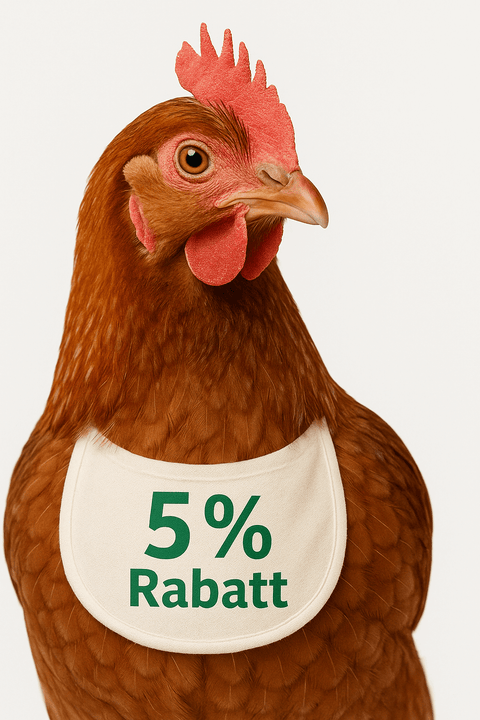Infestation in the chicken coop: How to get rid of the red mite
Tips and tricks for quick relief against red mites in chickens
Feather pecking, reduced egg production, and stressed chickens? These symptoms can indicate red mites. In severe cases, the infestation can even be life-threatening for our feathered friends. Learn how to prevent an infestation and what to do if your chickens are already infected in this blog post.
Infested chickens? How to recognize the red mite
The red mite, also known as Dermanyssus gallinae is a tiny but extremely annoying ectoparasite. It infests not only wild birds but also chickens and is a recurring problem for chicken keepers. The mites feed on the chickens' blood, which can lead to significant blood loss. The mites multiply explosively, especially at high temperatures between 20 and 25 degrees Celsius. It is therefore not uncommon for chicken keepers to struggle with this parasite, especially in summer.
The red poultry mite can be identified by its color. Depending on the amount of blood ingested, it ranges from light gray to dark red. Females are slightly larger at 0.8 millimeters, compared to males at 0.6 millimeters.
Lifestyle of the red mite
The spider-like parasite attacks its hosts primarily at night; during the day, the mites hide in crevices or notches in the perch. There they also lay their eggs and reproduce. In severe infestations, they also feed on the chickens' blood during the day.
Under ideal conditions, it takes only a week for the mite to develop from egg to adult. At temperatures between 20 and 25 degrees Celsius, the mites usually only survive for six to 14 days, but at low temperatures between 10 and 15 degrees Celsius, the parasite's survival time can be more than six months.
This indicates an infestation of red mites in chickens
Because the blood-sucking parasite is barely visible during the day, the red mite is considered particularly insidious. But how can you detect an infestation in chickens? Infected birds are usually restless at night and have difficulty sleeping. However, they sleep during the day and appear exhausted and listless.
These symptoms also indicate red mite infestation:
- Pale egg yolk
- Blood splashes on eggshells
- Laying eggs outside the nest
- Reduced egg production
The parasites are particularly harmful to young birds. The consequences can range from weakness to death. Furthermore, the red mite can transmit viruses and bacteria to chickens, which in turn promotes further diseases. In severe infestations, the mites can also migrate into living areas and infest humans and pets. The parasite's bites cause itching and unpleasant skin irritations in humans.
How to quickly get rid of red mites in chickens
If your chickens are infested with red mites, you don't necessarily have to resort to chemical treatments. For example, it can be helpful to rub the mites' hiding places with rapeseed oil. Another effective, natural remedy is a dust bath. Cumbasil Mite The mineral powder adheres to the chickens' feathers and footpads, making it almost impossible for mites to penetrate the feathers. The dust bath not only protects against mites, but also provides the birds with a source of entertainment to prevent feather pecking and stress – also symptoms of a mite infestation.
Together with the Blood Shield This is an ideal treatment combination against the red mite. Blood Shield is a herbal supplement that makes chicken blood unattractive to the mites. In acute infestations, the product can be administered once daily via the drinking water. You can also find out how to use the dust bath and the herbal extract in our Video about the red mite In it, Sabrina Wienecke, whose chickens were also infected with the parasite, describes how she successfully solved the problem.
How to support the intestines and egg production after a mite infestation
It should not be overlooked that the chicken intestines are often weakened after a mite infestation. The stress caused by the mites can impair the birds' immune systems. This, in turn, allows harmful microorganisms to penetrate the intestines and promote infections. Furthermore, the effects of the mite infestation drain the chickens' energy. This energy is then lost for other vital functions, and the birds lay significantly fewer eggs. Therefore, it is recommended to support the intestines after a red mite infestation. A balanced and nutrient-rich diet with essential vitamins, minerals, and proteins is especially important at this time. This is because, due to their short digestive tract, chickens have a fast metabolism, and the nutrients they absorb are not stored for long.
For example, adding probiotics – live microorganisms – can positively influence the intestinal flora by promoting beneficial bacteria. Adding a little apple cider vinegar to drinking water can also help regulate the intestinal environment and support digestion. Little tip: The KE herbal extract Additionally, it provides your chickens with optimal nutrients from the herbal world and helps build up their intestines.
How to prevent a red mite infestation
However, the best way to combat this parasite is still prevention. To prevent a red mite infestation, the chicken coop should be cleaned regularly. Particular attention should be paid to cracks, crevices, and corners, as the mites like to hide there. Frequent ventilation and an appropriate temperature are also essential to prevent excessive humidity. It is also recommended to regularly inspect the coop to detect mite infestations early.
The dust bath can be used preventively Cumbasil Mite offered to the animals. This not only helps combat mites, but also encourages the chickens' natural behavior—brooding. In the case of an acute mite infestation, additional measures can be added.
With a few natural remedies, red mites will no longer stand a chance in your coop. This way, you can prevent stress and contribute to the health of your feathered friends.


